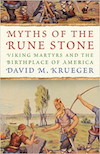Did a group of Christian Vikings from Sweden and Norway travel by river to Douglas County, Minnesota, in the fourteenth century only to be massacred by Native American “skraelings?” This is not the question that most interests David M. Krueger in his new book Myths of the Rune Stone: Viking Martyrs and the Birthplace of America.
Instead, Krueger asks why a variety of people—Scandinavian immigrants, American Catholics, and now dubious researchers on The History Channel—have become invested in this idea. Who was “here first?” Who is a “real” American? And were white settlers guilty or innocent in removing an indigenous population? A story carved on a strange stone uncovered by a Swedish immigrant has allowed Americans to imagine new answers to these questions. Without being credulous about the Kensington Rune Stone’s authenticity, Krueger examines its “sacred civic” function of creating an ordered world in in which its believers can meaningfully dwell.

Myths of the Rune Stone: Viking Martyrs and the Birthplace of America
David M. Krueger
University of Minnesota Press, Oct. 1, 2015
Ohman’s discovery came in the midst of what historian Odd Lovoll called “the cult of Leif Eriksson.” In an era of Nativist politics, the idea that Vikings had arrived in America before Columbus gave Minnesota’s Scandinavian immigrants a sense that America was their rightful home.
As early as 1898, a Scandinavian linguist from the University of Minnesota concluded that the Rune Stone was inauthentic and that the inscription was a mish-mash of modern Swedish, Norwegian, and English words, not Old Norse. But controversy over the Rune Stone’s authenticity only added to its fame.
In the early twentieth century, Norwegian immigrant Hjalmar Holand produced numerous writings advocating the Rune Stone’s authenticity and extrapolating further details about its authors.
He discovered a decree written by King Magnus of Sweden in 1354 commissioning an expedition to Greenland. There were rumors that some Greenlanders had fallen away from Christianity and the expedition was charged with finding these fallen Norseman and returning them to the church. It’s not clear that the decree was actually carried out, but Holand concluded that the men Magnus sent to Greenland sailed through the Hudson Bay and up the Nelson and Red Rivers, arriving in Minnesota. This interpretation made the Rune Stone a source of religious identity as well as ethnic pride.
Holand also expanded on the Rune Stone’s narrative to cast the Vikings as Christian martyrs slaughtered by Native Americans, which resonated with Minnesotans who still remembered the Dakota War of 1862. After years of treaty violations by the United States, several bands of Sioux engaged in armed conflict against settlers resulting in hundreds of deaths on both sides.
The story of martyred Vikings contributed to a legitimating myth of “innocent domination,” in which whites were victims rather than aggressors. At the Runestone Museum in Alexandria, Minnesota, contemporary displays about the Dakota War continue to present a narrative of white innocence. Krueger explains, “The Kensington Rune Stone became a tool in a ‘cosmic war’ between the forces of savagery and civilization that used a mythic past to justify the policies of the present.”
While the majority of the Scandinavian immigrants to the Midwest were Lutherans, Catholics embraced the Rune Stone as a testament to Catholic martyrdom. Also the target of Nativism, American Catholics could now claim that America had been consecrated with the blood of Catholic martyrs long before the arrival of the Pilgrims. John Ireland, the archbishop of St. Paul and an important Catholic intellectual, endorsed the Rune Stone’s authenticity in 1909.
Catholics also made much of the invocation to “AVM,” which they assumed stood for “Ave Virgen Maria.” (Others suggested this was actually the Hindu syllable “aum,” which was popular in Western esoteric circles when the stone was discovered.) In 1957 Bishop Peter W. Bartholome commemorated a shrine to “Our Lady of the Runestone” in Alexandria, Minnesota.
Just as the Rune Stone Vikings were continually re-imagined, so too were the Native Americans who killed them. Krueger demonstrates how, “The skraeling endured as a convenient symbol for the threats posed by secularization, urbanization, and diversification.” During the Cold War, a Wisconsin nun noted that the Christians who carved the Rune Stone were “uncommonly handy with a battle axe” and opined that such militant Christians are again needed today.
Contemporary “outlaw archaeologists” continue to draw new narratives from the Rune Stone using such techniques as dowsing rods for divining hidden codes within the runes. Some of these new narratives describe large settlements of Christian Vikings who lived in Minnesota for centuries following Leif Eriksson’s arrival in Vinland. There is a ready market for such wild speculation on cable television, but Krueger notes that these tales of ancient European settlers effectively marginalize America’s actual original inhabitants.
Krueger’s analysis of how history is re-imagined to serve a variety of civic, ethnic, and religious agendas is especially timely today as conservatives in Texas have pressured textbook companies into producing materials that present America’s origin as an explicitly “Christian nation,” while whitewashing the treatment of Native Americans and enslaved Africans.
Critical historiography is needed to counter these renewed myths of innocent domination. But Krueger’s work also does something equally important: By tracing the evolution of the Rune Stone story, he helps us to understand the needs and motivations that give rise to these myths. Perhaps these insights can help us to form sharper distinctions between historiography and myth-making.





